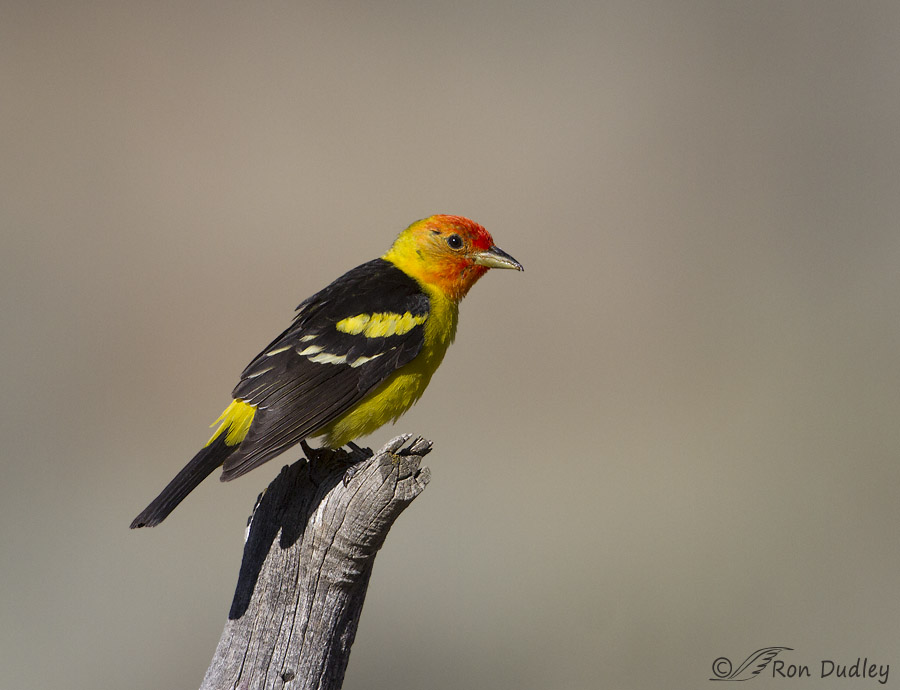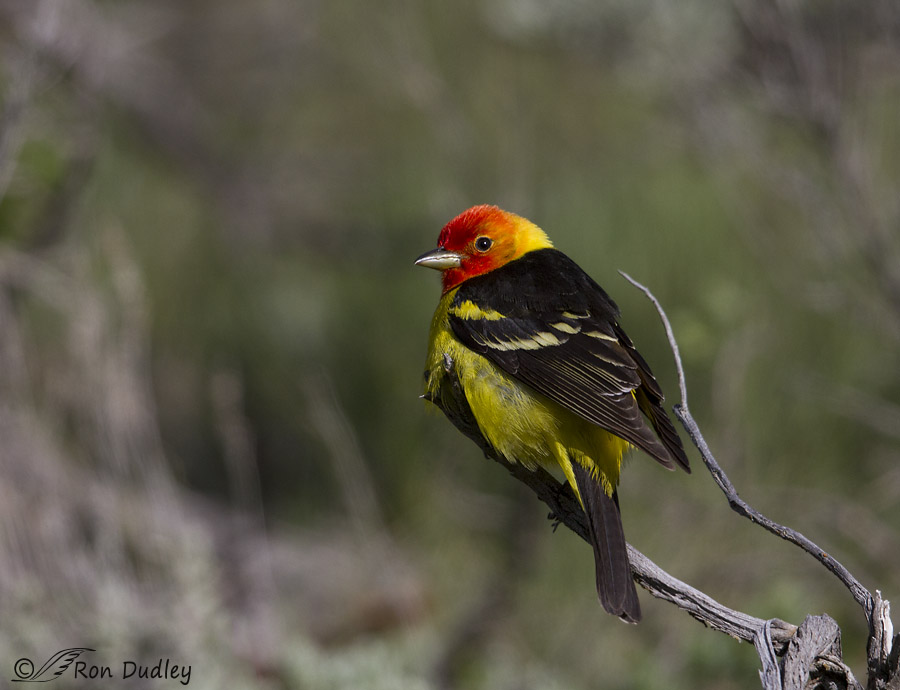Male Western Tanagers are known for their red heads but there can be considerable variation in those reds and the cause is not fully understood.

1/3200, f/5.6, ISO 500, Canon 7D, Canon EF500mm f/4L IS II USM +1.4 tc, not baited, set up or called in
The reds in other North American tanager species (Scarlet, Summer and Hepatic tanagers) are derived metabolically from yellow pigments consumed in their diets but the pigment (rhodoxanthin) responsible for the red head of the male Western Tanager is acquired directly from the diet without modification.
There’s also considerable variation in the reds of the male among individuals. They vary from light orange to deep scarlet and may be restricted to the forehead and throat or they may cover most of the head (and anything in-between those extremes). The cause of that variation is not understood.
Both of the Western Tanagers presented here were photographed near the border of southwest Montana and Idaho earlier this summer. The red pigments of this male are less intense and slightly more orange…

1/5000, f/5.6, ISO 640, Canon 7D, Canon EF500mm f/4L IS II USM +1.4 tc, not baited, set up or called in
than those of this male photographed a few weeks earlier. I’ve seen significantly more variation in other tanagers but don’t have photos of them. Rhodoxanthin is a very uncommon pigment in birds, having been detected only in a few pigeon species, several cotingas (a family of Central Americana passerines) and a manakin (a small and unique group of tropical American birds). Tiny amounts have also been detected in Northern Cardinals and Cedar Waxwings.
There also appears to be a geographic component to head color variations in male Western Tanagers. In most males the throat is orange and the color does not extend beyond the throat but in birds at the base of the eastern Rocky Mountains those colors are sometimes bright, poppy red and extend down over the chest.
Forgive me, I sometimes get carried away with details but in this case they do intrigue me so I just let myself fly with it (even though I’ve touched on this subject in a previous post).
Ron
PS – Several readers have asked me to keep them updated on developments with my new camera, the Canon 7D Mark ll. There’s not much to report at this point as I didn’t get it until yesterday afternoon and the next several days will be largely devoted to a fairly intense learning curve. Hopefully the weather and light will cooperate so that I can spend some much-needed time with it in the field.


Beautiful shots!!
Charlotte
I have had an absolutely vile morning. And, as I said to Mia, visiting your sites gave me a much needed splash of beauty – and education. Megathanks.
Dang, I’m so very sorry to hear that Elephant’s Child. I wish for you better days, beginning immediately! And thank you.
This is really a beautiful bird! Your photos are fantastic. The head on this bird looks just like my Sun Conure. Only difference is Conures have white around their eyes.
Thank you, Debbie.
Beautiful photos of one of the most vibrant (and brief) visitors to my backyard birdbath last spring; it was such a brilliant orange-red the first time I saw it, I was sure I must have imagined it. And, of course, the color dispersal was somewhat different from the photos I had seen in my guides. Then he returned twice more during the week. Thanks for the discussion of the variations.
Thank, Chris. You’re lucky as I’ve only seen one in my yard in the 25+ years I’ve lived here.
Fascinating!
Thank you, Arwen.
Ron–thanks for this very specific info–as I’m a painter, I’m especially interested in coloration. I’ve seen only 1 Western Tanager ( far Southern Utah ) and his head was brilliant solid red-orange. Without the
information you just provided, I would have doubted my memory of the first ( if I’m lucky enough to have a subsequent ) sighting……
Great! I’m glad to hear it was helpful, Kris.
Extremely interesting post, Ron! I’ve never seen the Western Tanager but your fantastic photographs almost count as a sighting! It would have been easy to assume their coloration was due to the same process as their cousins. Now we know differently!
I would say good luck with your new camera but any photographic device in your hands will be capable of stunning results. I have a couple of friends still waiting (vey impatiently) for theirs to arrive. It looks like a great tool!
Wally, it’s fine with me if you tick this species off as a sighting on your list now!
I went out shooting this morning and I was really fumbling around with the new camera. I’ve definitely got some learning to do…
I love that I can learn all sorts of new things when I read your blog. Thank you!
Mary, As far as I’m concerned you couldn’t have said anything much nicer than that!